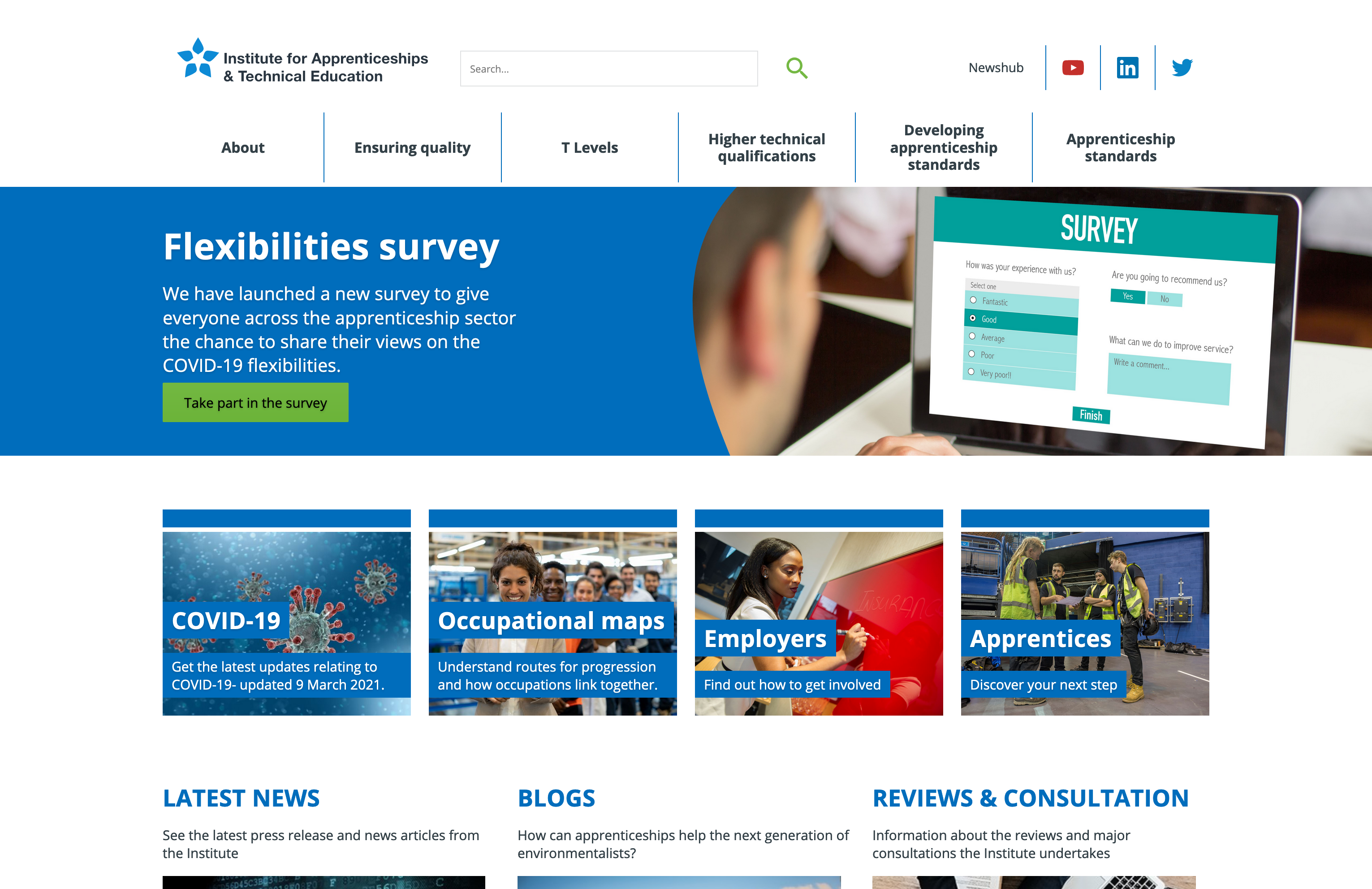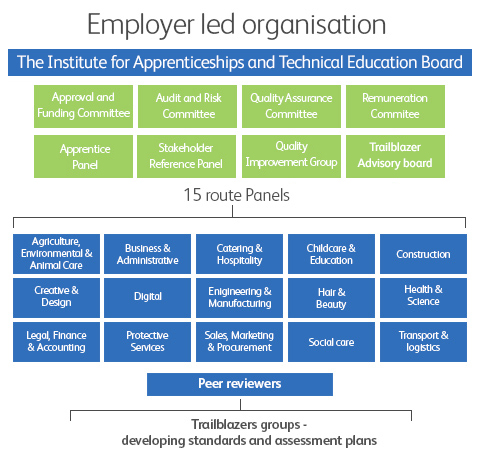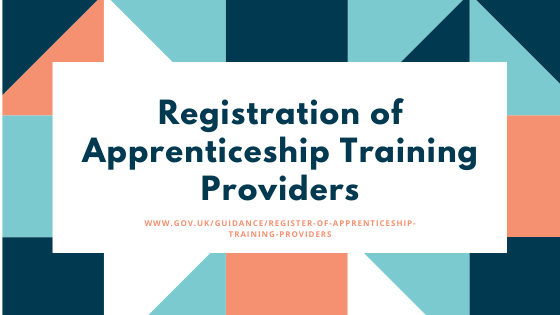About Apprenticeships
Overview of Reforms

Employers can genuinely ‘hold the pen’ to set out the skills, knowledge and behaviours that they expect in their future workforce. For the first time, this allows employers across a sector or a range of sectors to come together and ensure that their future apprentices will have exactly what they need to help their businesses flourish.
Businesses of all sizes are working closely together to design apprenticeship standards. They also consult with their sector to ensure that what they produce meets the needs of employers of all sizes and in every area of the country.

From 1st August 2020 all new apprenticeships must be signed up on an apprenticeship standard. Standards replace frameworks; the aim is to complete all existing frameworks by 31st August 2025.
‘The 2012 Richard Review into English apprenticeships was clear that the government should be encouraging more apprenticeships, but that significant changes were needed to increase provision. Of particular note were the importance of making apprenticeships more rigorous and making them more responsive to employers’ needs.'
Much progress has been made since then, including a clear commitment from the government to replace the old set of apprenticeship frameworks with employer-designed apprenticeship standards that are more aligned to the knowledge, skills and behaviours that employers are looking for.

The Institute will take the lead on a number of ongoing reforms to improve the apprenticeships system. Many of these reforms were initially driven by the 2012 Richard Review findings on the old apprenticeships system, including that:
- the system was overly complex – with a huge number of qualifications and possible combinations, and overly-detailed specifications
- continuous assessment only tested the incremental progress of the apprentice, rather than whether they had reached the desired level of competency
- providers didn’t respond first and foremost to employer needs
There are 3 defining features of the emerging system that the Institute will regulate:
- employer-designed apprenticeship standards and assessment plans
- graded end point apprenticeship assessments
- external quality assurance of end point assessments
What is a trailblazer?
Apprenticeships are developed by trailblazer groups. These are groups which:

Have a wide range of employers who are committed to working actively on the development of a new apprenticeship standard, and intend to use the apprenticeship standard once it’s been approved for delivery
(see the overview section later in this introduction).

Have at least 10 different employers as members
(in addition to any professional bodies, trade associations, who want to be involved).

Reflect the range of companies which employ people in this occupation – including size, geographical spread and sector. Any trailblazer group should normally include at least 2 employers with fewer than 50 employees.
Process of creating the standard
Employers identify an unmet need for a standard in their occupation
Institute for Apprenticeships provides pre-proposal support
Trailblazer submits proposal to the institute for Apprenticeships
Institute reviews the proposal against policy criteria, and checks against the occupational maps as these evolve and accepts or rejects the proposal
Successful proposals are worked up into standards and assessment plans
Standards and assessment plans are submitted to the Institute for Apprenticeships when ready
There are institute and individual peer reviews of the submissions against the published criteria
Institute Route Panels consider recommendations and decide to approve, approve with conditions, or reject the standard and assessment plan
Board Approvals and Funding committee receives recommendation from Route Panel and takes final decision
Register of End Point Assessment Organisations (RoEPAO) opens for applications to offer end-point assessment of the new apprenticeship
Providers on Register of Apprenticeship Training Organisations (RoATP) are able to provide training for new standard
What is RoATP?
The register of apprenticeship training providers is a list of organisations that are eligible to receive government funding to train apprentices.
All organisations that want to receive government funding to train apprentices must be on the register.
Organisations must be on the RoATP if they are to receive government funding, including those delivering less than £100k per year as subcontractors. All providers currently on the RoATP will have to refresh / reapply periodically.
When engaging with training providers it is important to check they are on the RoATP. Each Provider will have a unique reference number which you will use to identify them on your digital account when setting up your apprenticeship programmes.

This is the organisation’s UK Provider Reference Number (UKPRN) as given by the UK Register of Learning Providers (UKRLP).
This is the organisation’s legal name from the UKRLP. ESFA also list trading names for sole traders and partnerships. ESFA source organisation names displayed in the apprenticeship service from UKRLP.
Providers choose the application route that is relevant to them.
If this field is set to 'TRUE', then the Education and Skills Funding Agency (ESFA) moderated the financial health outcome for this organisation to a pass due to the submission of a parent company guarantee.
If this field is set to 'TRUE', then the organisation has not been trading for a sufficient period to provide a complete set of financial statements. ESFA base a financial health judgement on management accounts and forecasts (where applicable).
This is the date that ESFA added the organisation to the RoATP.
If this field is set to 'TRUE', then the organisation has not been trading for a sufficient period to provide a complete set of financial statements. ESFA base a financial health judgement on management accounts and forecasts.
With the introduction of Standards, apprentices are now required to undertake an independent assessment at the end of the programme known as End Point Assessment (EPA). End Point Assessment Organisations (EPAO’s) are approved by the Institute for Apprenticeships and Technical Education (Skills England). EPAO’s can be found here https://www.gov.uk/guidance/register-of-end-point-assessment-organisations.
An apprenticeship programme is divided into two stages, Practical Period and End Point Assessment. The practical period is the pre-gateway stage delivered by the training provider. This contains all the training and development required including the achievement of any mandated qualifications listed in the Standard. Once the practical period is complete and the apprentice is ready to be assessed as occupationally competent they will pass through gateway into the end point assessment stage. Readiness for EPA is agreed between the training provider, employer and apprentice and should only be declared if all parties are happy no further development is required.
End point assessment has various elements, defined by employer trailblazer groups, to enable the apprentice to be assessed against the knowledge, skill and behaviour listed in the standard. Methods of assessment include, knowledge test (multi-skilled and extended answer questions), practical observations, professional discussions, projects, reports and presentations.
End point assessments are graded, typically Fail, Pass, Merit and Distinction. Should an apprentice fail any part of the EPA they may be allowed to re-sit the element/s (details in EPA plan).
